Bathroom Ceramic Tile Options and Considerations When Planning Your Bathroom Remodeling Project
By Mark J. Donovan
|
|
Incorporating bathroom ceramic tile into a bathroom remodeling project is a must do. Ceramic tile is commonly used in bathrooms on floors, walls, and around tub and shower enclosures. If you really want to create a high-end bathroom, you may want to go as far as even building a custom ceramic tile shower. Bathroom ceramic tile offers several advantages besides looking fantastic. It helps simplify bathroom cleaning, it’s durable, and it’s easier to prevent mold and mildew growth. Also, ceramic tile can also be purchased at reasonable prices, and most do it yourselfers can do their own bathroom tiling.
Ceramic tile is made from clay and quartz ferrous materials. The clay and quartz material are mixed with water and then formed into various tile shapes and sizes. |
The tiles are then fired at high temperatures in ovens to harden them. Porcelain tile uses more highly refined materials. As a result, porcelain tiles are denser and more rugged than ceramic tiles. Either tile, however, works well in a bathroom.
Unglazed ceramic tiles are fired and baked and the colors are determined by the mineral content in the clay and quartz material. Unglazed tiles are more porous and usually are thicker and have a matte type finish.
Consequently unglazed ceramic tiles are more appropriate for bathroom floors as they are slip resistant. An example of an unglazed tile type is a terracotta tile.
| Glazed tiles, on the other hand, have a very smooth glass like surface and thus are very shiny and often slippery. To achieve the glazed finish, the glazed ceramic tiles go through an additional process of having a glass layer applied to them, and then fired once again at a very high temperature. As a result, glazed tiles have a very smooth glass like finish and are slightly more fragile. Glazed ceramic tiles are best suited for bathroom walls and around tub and shower enclosures.
When it comes to actually tiling a bathroom, if you plan to use lighter tile colors consider using darker grouts to provide contrast and accent colors. Again, it is important to use a tile sealer, particularly on the grout lines to prevent grout stains and mold and mildew growth. |
 |
If you want to prevent the risk of stains, and mitigate the risk of mold and mildew growth, then use glazed ceramic bathroom tiles.
Also feel free to mix it up by using different tile colors to create unique patterns in your tiled bathroom floors and walls. In addition, for custom ceramic tile showers, use accent tiles to spice up the shower walls and floor.
If you plan to use tile for your bathroom countertops or backsplashes use glazed tiles, as again they are less susceptible to staining and can survive the cleansing strength of household cleaners.
Finally, when choosing ceramic tile colors make sure to select colors that complement the other items in the bathroom including window treatments, floor coverings, and even bathroom accessories such as soap dishes, towel bars, and toilet paper holders.
For information on installing a shower pan membrane liner for a ceramic tile shower, see the Shower Pan Membrane Liner Installation Ebook from HomeAdditionPlus.com. The Shower Pan Membrane Liner EBook will quickly teach you the step-by-step process for installing the shower pan membrane liner correctly. It includes instructions on framing the shower stall, pouring the pre-slope and shower base mortar, and installing the shower pan membrane liner.
See HomeAdditionPlus.com’s Ceramic Tile Calculator
See my “How to Tile a Custom Ceramic Tile Shower” Ebook to learn how to tile your own shower: For a detailed set of instructions on tiling a shower floor and walls, including pictures for every step in the process, see my “How to Tile Custom Ceramic Tile Shower Ebook”.
Related Information
Additional Ceramic Tile Resources from Amazon.com
 |
 |
 |
Get Free Bathroom Remodeling Price Quotes with No Obligation!
Fill out our 3-5 minute quick and easy form, and receive a free price quote on a bathroom remodeling project from one of our pre-screened and licensed bathroom remodeling contractors. This process is free and there is no obligation to continue once you receive your bathroom addition price estimate.

